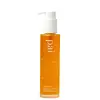What's inside
What's inside
 Key Ingredients
Key Ingredients

No key ingredients
 Benefits
Benefits

 Concerns
Concerns

 Ingredients Side-by-side
Ingredients Side-by-side

Olea Europaea Fruit Oil
MaskingHelianthus Annuus Seed Oil
EmollientPolyglyceryl-4 Oleate
EmulsifyingRicinus Communis Seed Oil
MaskingRosa Canina Fruit Extract
AstringentJasminum Grandiflorum Flower Extract
MaskingCitrus Aurantifolia Peel Oil
MaskingCitrus Aurantium Dulcis Peel Oil
MaskingPelargonium Graveolens Oil
MaskingOcimum Basilicum Oil
MaskingTocopherol
AntioxidantRosmarinus Officinalis Leaf Extract
AntimicrobialSqualene
EmollientBeta-Sitosterol
Emulsion StabilisingLimonene
PerfumingCitronellol
PerfumingGeraniol
PerfumingCitral
PerfumingLinalool
PerfumingOlea Europaea Fruit Oil, Helianthus Annuus Seed Oil, Polyglyceryl-4 Oleate, Ricinus Communis Seed Oil, Rosa Canina Fruit Extract, Jasminum Grandiflorum Flower Extract, Citrus Aurantifolia Peel Oil, Citrus Aurantium Dulcis Peel Oil, Pelargonium Graveolens Oil, Ocimum Basilicum Oil, Tocopherol, Rosmarinus Officinalis Leaf Extract, Squalene, Beta-Sitosterol, Limonene, Citronellol, Geraniol, Citral, Linalool
 Reviews
Reviews

Ingredients Explained
These ingredients are found in both products.
Ingredients higher up in an ingredient list are typically present in a larger amount.
Citronellol is used to add fragrance/parfum to a product. It is often derived from plants such as roses. In fact, it can be found in many essential oils including geranium, lavender, neroli, and more. The scent of Citronellol is often described as "fresh, grassy, and citrus-like".
Since the Citronellol molecule is already unstable, Citronellol becomes irritating on the skin when exposed to air.
Citronellol is a modified terpene. Terpenes are unsaturated hydrocarbons found in plants. They make up the primary part of essential oils.
Citronellol is not able to be absorbed into deeper layers of the skin. It has low permeability,
Citronellol is also a natural insect repellent.
Learn more about CitronellolGeraniol is used to add fragrance/parfum to a product. It is the main component of citronellol. It is a monoterpenoid and an alcohol.
Monoterpenes are naturally found in many parts of different plants.
Geraniol can be found in many essential oils including Rose Oil and Citronella Oil. The scent of Geraniol is often described as "rose-like". Many foods also contain Geraniol for fruit flavoring.
Geraniol can irritate the skin when exposed to air. However, irritation depends on the ability of geraniol to penetrate into the skin. In general, geraniol is not able to penetrate skin easily.
Geraniol is colorless and has low water-solubility. However, it is soluble in common organic solvents.
Like citronellol, it is a natural insect repellent.
2,6-Octadien-1-ol, 3,7-dimethyl-, (2E)-
Learn more about GeraniolLinalool is a fragrance and helps add scent to products. It's derived from common plants such as cinnamon, mint, citrus, and lavender.
Like Limonene, this ingredient oxidizes when exposed to air. Oxidized linalool can cause allergies and skin sensitivity.
This ingredient has a scent that is floral, spicy tropical, and citrus-like.
Learn more about LinaloolPelargonium Graveolens Oil is the pressed oil of the Rose Geranium plant. It has perfuming and masking properties.
This ingredient contains citronellol and geraniol. These compounds may cause allergies and skin-sensitivity.
The scent of Rose Geranium closely resembles. you guessed it: roses.
Learn more about Pelargonium Graveolens Oil